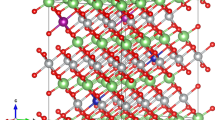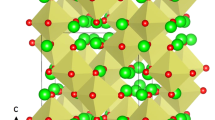Abstract
Electronic structures and vacancy formation of Li3N doped with 3d transition metals were studied using first-principles density functional theory simulations. It is found that dopant ionic radius may determine its substitution site in Li3N. Ti energetically favors substituting trigonal planar Li atoms (Li(2)) while other 3d transition metals prefer substituting Li atoms between layers (Li(1)). V, Cr, Mn, Fe, Co and Ni substitutions significantly lower the energy band gap with localized electrons at the Fermi level, suggesting induced electronic conduction. Transition metal substitution generally reduces Li vacancy formation energy and hence enhances the Li vacancy concentration. It is revealed that transition metals except Co and Cu strongly trap the neighboring Li vacancies based on the calculated dopant-vacancy binding energies, and may retard the Li ionic conduction. Our calculations confirm the reported excellent performance of Co-doped Li3N as anode material with improved ionic and electronic conduction, and suggest the relation of improved electronic conduction with localized electrons as well as the relation of enhanced ionic conduction with decreased vacancy formation energy and insignificant dopant-vacancy binding energy.



Similar content being viewed by others
References
Gregory DH (2008) Lithium nitrides as sustainable energy materials. Chem Rec 8(4):229–239
Schulz H, Thiemann KH (1979) Defect structure of the ionic conductor lithium nitride (Li3N). Acta Cryst A35:309–314
Nazri G (1989) Preparation, characterization and conductivity if Li3N, Li3P and Li3As. Mater Res Soc Symp Proc 135:117–129
Tarascon JM, Armand M (2001) Issues and challenges facing rechargeable lithium batteries. Nature 414(6861):359–367
Juza R, Langer K, Benda KV (1968) Ternary nitrides, phosphides, and arsenides of lithium. Angew Chem Int Ed 7(5):321–406
Niewa R, Wagner FR, Schnelle W, Hochrein O, Kniep R (2001) Li24[MnN3]3N2 and Li5[(Li1−x Mn x )N]3, two intermediates in the decomposition path of Li7[MnN4] to Li2[(Li1−x Mn x )N]: an experimental and theoretical study. Inorg Chem 40(20):5215–5222
Niewa R, Zherebtsov D, Hu Z (2003) Polymorphism of heptalithium nitridovanadate(V) Li7[VN4]. Inorg Chem 42(8):2479–2816
Rowsell JLC, Pralong V, Nazar LF (2001) Layered lithium iron nitride: a promising anode material for Li-Ion batteries. J Am Chem Soc 123(35):8598–8599
Stoeva Z, Gomez R, Gregory DH, Hix GB, Titman JJ (2004) Evolution of structure, transport properties and magnetism in ternary lithium nitridometalates Li3−x−y M x N, M = Co, Ni, Cu. Dalton Trans 19:3093–3097
Gregory DH, O’Meara PM, Gordon AG, Hodges JP, Short S, Jorgensen JD (2002) Structure of lithium nitride and transition-metal-doped derivatives, Li3−x−y M x N (M = Ni, Cu): a powder neutron diffraction study. Chem Mater 14:2063–2070
Cabana J, Stoeva Z, Titman JJ, Gregory DH, Palacín MR (2008) Towards new negative electrode materials for Li-Ion batteries: electrochemical properties of LiNiN. Chem Mater 20(5):1676–1678
Stoeva Z, Jäger B, Gomez R, Messaoudi S, Yahia MB, Rocquefelte X, Hix GB, Wolf W, Titman JJ, Gautier R, Herzig P, Gregory DH (2007) Crystal chemistry and electronic structure of the metallic lithium ion conductor LiNiN. J Am Chem Soc 129(7):1912–1920
Nishijima M, Kagohashi K, Imanishi M, Takeda Y, Yamamoto O, Kondo S (1996) Synthesis and electrochemical studies of a new anode material, Li3−x Co x N. Solid State Ion 83(1–2):107–111
Shodai T, Okada S, Tobishima S, Yamaki S (1996) Study of Li3−x M x N (M: co, Ni or Cu) system for use as anode material in lithium rechargeable cells. Solid State Ion 86–88(2):785–789
Kresse G, Furthmuller J (1996) Efficiency of ab initio total energy calculations for metals and semiconductors using a plane-wave. Comput Mater Sci 6(1):15–50
Perdew JP, Burke K, Ernzerhof M (1996) Generalized gradient approximation made simple. Phys Rev Lett 77(18):3865–3868
Perdew JP, Burke K, Ernzerhof M (1997) Errata: generalized gradient approximation made simple. Phys Rev Lett 78(7):1396
Heyd J, Scuseria GE, Ernzerhof M (2003) Hybrid functionals based on a screened Coulomb potential. J Chem Phys 118(18):8207
Heyd J, Scuseria GE, Ernzerhof M (2006) Erratum: “Hybrid functionals based on a screened Coulomb potential” [J Chem Phys 118, 8207 (2003)]. J Chem Phys 124(21):219906
Kresse G, Joubert D (1999) From ultrasoft pseudopotentials to the projector augmented-wave method. Phys Rev B 59(3):1758–1775
Wu SN, Dong ZL, Boey F, Wu P (2009) Electronic structure and vacancy formation of Li3N. Appl Phys Lett 94:172104
Shannon RD (1976) Revised effective ionic radii and systematic studies of interatomic distances in halides and chalcogenides. Acta Cryst A32:751–767
Gregory DH (2001) Nitride chemistry of the s-block elements. Coord Chem Rev 215(1):301–345
Stoeva Z, Gomez R, Gordon AG, Allan M, Gregory DH, Hix GB, Titman JJ (2004) Fast lithium ion diffusion in the ternary layered nitridometalate LiNiN. J Am Chem Soc 126(13):4066–4067
Gordon AG, Smith RI, Wilson C, Stoeva Z, Gregory DH (2004) Crystal growth, defect structure and magnetism of new Li3N-derived lithium nitridocobaltates. Chem Commun 24:2812–2813
Niewa R, Huang Z-L, Schnelle W, Hu Z, Kniep R (2003) Preparation, crystallographic, spectroscopic and magnetic characterization of low-valency nitridometalates Li2[(Li1−x M x )N] with M = Cu, Ni. Z Anorg Allg Chem 629:1778–1786
Stoeva Z, Smith RI, Gregory DH (2006) Stoichiometry and defect structure control in the ternary lithium nitridometalates Li3−x−y Ni x N. Chem Mater 18:313–320
Author information
Authors and Affiliations
Corresponding author
Rights and permissions
About this article
Cite this article
Wu, S., Wu, P. Variation of band gap and vacancy formation energy of lithium nitride with 3d transition metal substitution. J Mater Sci 52, 9780–9786 (2017). https://doi.org/10.1007/s10853-017-1163-x
Received:
Accepted:
Published:
Issue Date:
DOI: https://doi.org/10.1007/s10853-017-1163-x




